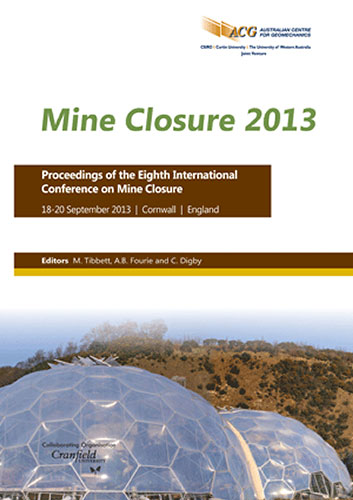Design, construction and monitoring of the final cover on Wismut’s Truenzig tailings facility

|
Authors: Merkel, G; Lindner, S |
DOI https://doi.org/10.36487/ACG_rep/1352_16_Merkel
Cite As:
Merkel, G & Lindner, S 2013, 'Design, construction and monitoring of the final cover on Wismut’s Truenzig tailings facility', in M Tibbett, AB Fourie & C Digby (eds), Mine Closure 2013: Proceedings of the Eighth International Seminar on Mine Closure, Australian Centre for Geomechanics, Cornwall, pp. 183-194, https://doi.org/10.36487/ACG_rep/1352_16_Merkel
Abstract:
In East Germany, uranium mining and milling by the Soviet-German Wismut company lasted from 1946 to 1990. Since 1991 the Wismut GmbH has been remediating the legacies from uranium production. The Trünzig tailings facility near Seelingstaedt (Thuringia) covers 117 ha and contains 19 million m3 of uranium mill tailings from the former Seelingstaedt uranium milling and processing plant. The remediation of Wismut´s tailings facilities constitutes one of the greatest challenges to the remediation effort in engineering as well as ecological and financial terms. The Truenzig tailings facility is being remediated dry in situ and involves the following remediation steps: removal of pond water, catchment of contaminated seepage and surface runoff, interim covering of tailings surfaces, recontouring of dams and pond areas and placement of a final cover, including revegetation. Speeding up the consolidation of soft fine tailings during remediation is of crucial importance to ensure work safety during remediation and long-term stability of the soil cover. The final cover is to prevent access to radioactive tailings and dusting, control the percolation rate, limit oxygen intrusion and radon exhalation and provide long-term geotechnical and erosional stability with respect to time-settlements of the underlying tailings. This paper presents a case study of the final covering, including preparative measures along with planned runoff diversion trenches intended to enhance consolidation of soft fine tailings. For this purpose, vertical wick drains were installed down to a depth of up to 27 m, and embankments were placed for surcharge loading. The design of the final cover was derived with respect to its functional performance criteria in terms of water balance, geotechnical and erosional stability. The design follows the principle of a store-and-release cover. On sandy tailings beaches, it consists of a 2 m thick moisture storage layer of mixed-grained soil (waste rock from overburden dump) underlain by a 1 m thick interim cover layer made of the same soil but compacted to a hydraulic conductivity kf of ≤ 5*10-9 m/s. On soft fine tailings areas, the final cover has a minimum thickness of at least 2.5 m of mixed-grained soil (waste rock from overburden dump). Completion of the final covering is scheduled for 2013. Runoff diversion from the last remaining section of the tailings facility to the receiving stream is envisaged to be realised in 2014. The paper details the technical design, preparative measures and the final cover, the monitoring systems installed, monitoring results with respect to the final cover´s functional performance and experiences from 2005 to 2012.
References:
Neudert, A., Kahnt, R., Lindner, T., Löbner, W., Grossmann, T. and Weissbach, C. (2000) Optimization final cover of the Truenzig tailings facility, Wismut Ltd., November 2000, Chemnitz, Germany, 229 p.
Oswald, K. and Lindner, S. (2001) Final covering Truenzig tailings facility to ensure long term safety, C & E Consulting & Engineering Ltd., December 2001, Chemnitz, Germany, 47 p.
Roscher, M. and Jahn, S. (2013) Report on soil hydrological monitoring for the cover of Truenzig tailings facility in 2012, Wismut Ltd., February 2013, Chemnitz, Germany, 28 p.
© Copyright 2025, Australian Centre for Geomechanics (ACG), The University of Western Australia. All rights reserved.
View copyright/legal information
Please direct any queries or error reports to repository-acg@uwa.edu.au
View copyright/legal information
Please direct any queries or error reports to repository-acg@uwa.edu.au